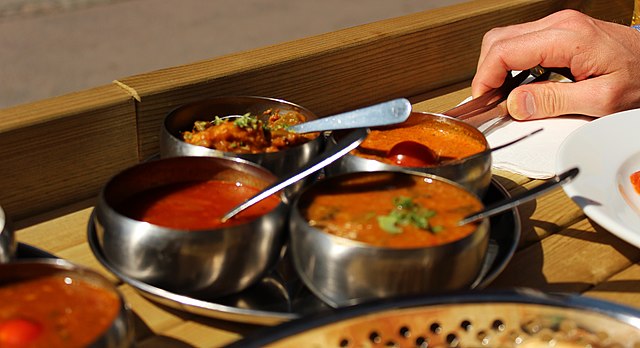(NEW YORK) — In the East Village, where Indian restaurants are as ubiquitous as the Ubers and Lyfts crowding Second Avenue, a casual dinner suggestion quickly reveals the complexity of identity in New York’s culinary map:
“What are you feeling for dinner tonight?”
“Let’s do Indian. Can we hit Taj?”
“You mean you want Bangladeshi food, then?”
On a street packed side by side with South Asian eateries, the distinction between Indian and Bangladeshi cuisine can blur, illustrating the migration stories behind the menus and the evolving tastes of a city that prides itself on its endless variety. The shuttered Taj, once a neighborhood staple on 6th Street, serves as a reminder of the fleeting nature of New York dining establishments and the lasting impact of their flavors.
Taj was formerly on 6th Street, a staple in East Village, serving Indian food. Outside, a chalkboard sign proclaimed, “Craving curry? We got you.” The ambiance included dim lighting, a well-stocked bar, and an eerie paper mache lion head on the wall. Taj was among the first to introduce classic Indian cuisine to NYC’s food-curious populace.
Panna II, Milon, and Haveli followed its lead, all on the same block. These establishments and a remaining grocery store once formed a vibrant enclave known as Little India. However, despite their Indian menus, the cooking staff and management, primarily Bangladeshi immigrants, often omitted traditional Bangladeshi ingredients.
For decades, this neighborhood was renowned for its extremely affordable eats, providing many New Yorkers with their first taste of South Asian flavors.
The culinary revolution began in the 1970s, between 1st and 2nd Avenues, with the emergence of unassuming Bangladeshi eateries like Shah Bag, Purbo Rag, Kismoth, and Anar Bagh. These humble establishments paved the way for introducing the captivating flavors of South Asia to the city. Today, East 6th Street stands as a testament to the diversity and innovation of South Asian cuisine, although it has transformed over the years.
While Milon and Panna II continue to operate side-by-side, Taj and Haveli have shut their doors. The restaurants of Little India played a crucial role in popularizing the cuisine and introducing essential Indian spices to the city. For decades, East 6th Street served as a haven for non-Indians craving Indian food and Indians seeking something reminiscent of home.
A 15-minute walk south from Little India on Essex Street or a quick subway ride to the Delancey Street stop on the F train leads to an unexpected culinary gem. Nestled between a Regal Cinemas and just a short distance from the Williamsburg Bridge is Dhamaka, an upscale restaurant that proudly claims to be “unapologetically Indian.”
The restaurant dazzles with vibrant colors and a floating indoor bar, ensuring there’s always something to catch your eye. Signature drinks like the Goan Gangster and Gee Whiz prompt curious glances and the question, “Can I have what they’re having?”
Forget everything you think you know about Indian cuisine; Dhamaka’s menu explores the “other side” of India—the “forgotten side,” as they describe it.
As Dhamaka’s carefully curated menu introduces increasingly curious eaters to underrated Indian cuisine, will the need for old-school eateries in Little India persist?
India Witkin, a multimedia storyteller, delves into migration, race, and gentrification through the lens of food. Her podcast, “Eating America with India,” tackles significant questions alongside chefs, historians, and journalists who share their experiences with diasporas.
Witkin has interviewed key figures in the food industry, from the owner of Chinatown’s oldest dim sum restaurant in New York City to the manager of one of the earliest Hindu temples in the country, which also offers authentic South Indian cuisine in its basement.
Half-Indian herself, Witkin deeply respects the no-frills mom-and-pop shops catering to the South Asian community. She notes that such establishments are thriving in areas like Jackson Heights, Astoria, and Flushing, continuing to offer authentic and affordable options to New Yorkers.
Newer Indian restaurants around Manhattan cater to a different clientele, often in wealthier neighborhoods like the West Village, Lower East Side, and Park Slope. These venues cater to those seeking an Indian dining experience, not just a meal. “I think there is space for both,” asserts Witkins.
Last year, for my 23rd birthday, my (ex-)boyfriend surprised me with a dinner reservation at Dhamaka after months of hinting. I had been looking for any excuse to go, but (as a broke graduate student) I couldn’t justify the steep price point. However, the anticipation made the experience all the more special. “I had to make a reservation a month in advance,” he whispered as the line grew behind us outside the restaurant.
From my first bite of their gurda kapoora—goat kidneys and testicles—I knew Dhamaka was here to stay. I grew up visiting one of Flushing’s many chicken coops with my dad. Once inside, after careful consideration, he’d point to the bird he wanted on his dinner plate that evening. As a child, I cried incessantly outside the coop while we waited for the butcher to hand us a limp bag of chicken meat and giblets. However, I happily shoved delicious curried chicken heart and liver into my mouth just a few hours later. Dhamaka’s buttery goat on a soft fluffy pao bun reminded me of flavors I never thought I’d experience outside my mom’s kitchen.
Dhamaka was the only Indian restaurant with the guts to put guts on their menu.
“Indian food is certainly having a moment,” observes Witkins. “These upscale restaurants are cleverly redefining traditional dishes, making lesser-known delicacies more accessible.”
As I sat down with Chef Neel Kajale a year later, he shared insights into Dhamaka’s ever-evolving menu.
We settled into the outdoor dining area and Kajale cleared the table for our conversation. The silver plates and beautifully colored canopy almost make you forget that you’re at one of New York’s oldest and busiest markets; the only reminder being the ever-present sounds of the city — firetrucks and blasting stereos.
Kajale’s itch for “fine dining” propelled him into incredible kitchens – from The Bombay Canteen in Mumbai to Eleven Madison Park in New York City. Yet, after only one year in a three-Michelin-star restaurant, Kajale knew he needed to make a change.
“It’s just not for me,” he said. “It took me a while to realize that the cooking I want to do is cooking that makes me happy, where everyone in my kitchen is having fun.”
Which is how he found himself as the head chef at Dhamaka. Although it is his first time running a restaurant, Kajale feels it is a role he’s been prepping and training for for the last seven years. He admits that he carries great responsibility, learning how to balance the duties of a chef and a manager.
“It’s nice to be captain of the ship,” says the chef. “There’s pressure, but it never gets stressful.”
Kajale is looking to put Indian food at the forefront of people’s minds and palettes.
His passion for cooking stems from the matriarchs in his family – and the care they put into presenting innovative and diverse dishes on the dinner table. Kajale’s family members are his biggest supporters, pushing him to pursue his culinary dreams with only one piece of advice, “Don’t be mediocre.” And while Kajale affirms that no one can beat his mom’s cooking, he knows there is a way to bring those same Indian flavors to “foodies” in New York City.
“There’s a reputation that Indian food is ‘curry house food’ that you only get when you’re drunk,” he notes. “We want to change that. We can make experiences out of the food that we’re doing.”
And, at Dhamaka, that starts with getting rid of the tired and true Indian classics. When asked what item he’d kick off Indian menus, Kajale might have broken the hearts of many Indians.
Vegetable samosas.
“Everyone’s done it. Everyone knows about it now,” he said.
As a South Indian myself, I can confirm that Dhamaka’s menu challenges what people expect from an Indian restaurant. Kajale says that many people come in asking for garlic naan without glancing at the menu and leave very disappointed after being informed that Dhamaka might be the only Indian restaurant in New York without a tandoor oven – and they’re proud of it.
But don’t fret, Kajale is keeping biryani on the menu (only if it’s mutton though). He feels that biriyani, a popular mixed rice dish, showcases how technical and intricate Indian cooking can be – especially the process of laboriously layering meat, rice, and sauce.
A dish that has been talked about endlessly on Dhamaka’s menu is their rajasthani khargosh, a $190 whole rabbit that can be extremely difficult to reserve. You have to pre-order it at least two days in advance, and Dhamaka only serves one per night. Kajale says this one dish has changed the perception of Indian cuisine and the depth of its repertoire. This dish – and many others – embodies Dhamaka’s tagline: “The forgotten side of India.”
“What makes them special is that they’ve never been done before,” said Kajale. “More people need to be aware of it and more people need to eat it.”
The process for menu creation is fairly simple, according to Kajale. In fact, he says a lot of these dishes are conceptualized by just talking to the people around him. One of the items on the menu right now – the kolambi ani kekda bhaath – is his mother’s recipe for a delicious shrimp and crab pulao. Since being on the menu, Kajale says customers have likened it to paella, the familiar brininess from the seafood paired with crispy rice that sticks to the bottom of the pan.
“When people tell me that this reminds them of the food back home in India, I feel like we’ve done our job,” Kajale said. “I feel like a big part of the reason that we’ve been successful is because we are so confident and almost arrogant about the food.”
While Dhamaka has undoubtedly become a well-known name amongst the Indian community in New York City, Kajale notes that the restaurant serves a very judicious mix of Indian and non-Indians. But that doesn’t mean he’s changing the rules for anyone.
“We shamelessly tell people to eat with their hands,” he said. “That’s when the food tastes the best.”
Even down to the presentation, Dhamaka strives to put forth the most authentic Indian dining experience. As in many Asian cultures, meals are often served family-style – usually a big pot of curry is placed on the dinner table, surrounded by all its side dishes. And that’s exactly how it’s done at Dhamaka as well, the curries are served in the dishes that they’re cooked in and they arrive at your tableside, piping hot.
“I hope we’re able to set a standard so that every other experience feels incomplete,” Kajale said.
The culinary landscape in Queens, with its array of mom-and-pop eateries, sharply contrasts with Manhattan’s upscale Indian dining scene, which offers experiences savored occasionally rather than daily. Yet, Kajale and I agree that places where one can grab five samosas for $5 prove that the need for affordable, authentic food is perpetual.


